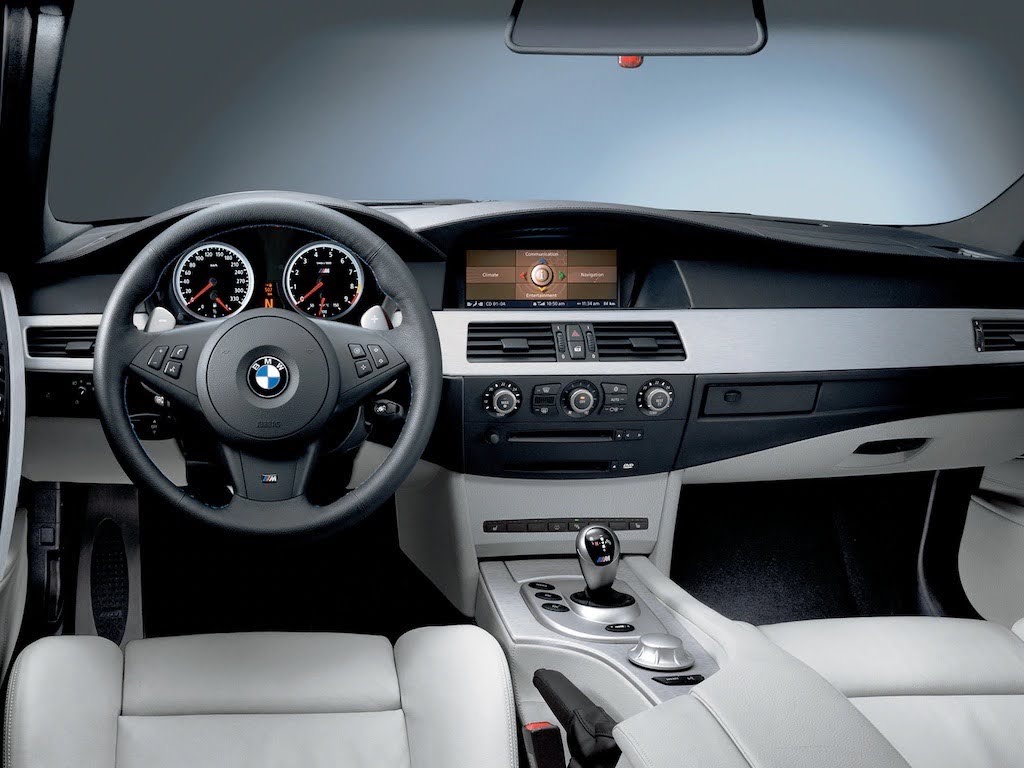
When the BMW E60 first showed up in the early 2000s, it was clear the German automaker was out to make a point with a breath of fresh air.
Underneath the styling, electronic features, and a new iDrive system that confused just about everyone, the E60 was still a proper 5-Series. It handled well, cruised comfortably, and offered a range of engines that could be calm or chaotic, depending on your mood. It ticked the right boxes. Then it kept ticking them until the warranty ran out and reality set in.
It’s been over a decade now since the E60s were discontinued. So you are now dealing with a very different kind of 5-Series. One that may leave a small oil puddle in your driveway. One that occasionally forgets what gear it’s in. And one that sends warning lights just to see if you’re paying attention.
This guide is for owners who want to keep their E60 running well without losing sleep over every hiccup. We’ll walk through the most common problems and routine maintenance a BMW specialist will handle as it ages. While the E60 is still worth owning, it is also worth understanding what you’re in for with this now classic car.
Engine & Oil Leaks

Image Source: BMW-M
One of the most common issues across all E60 variants is oil leakage. These cars are known for developing leaks from multiple seals and gaskets as they age. The valve cover gasket, oil filter housing, and oil pan are frequent offenders. On V8 models like the 545i and 550i, valve stem seals are another weak point and often lead to noticeable smoke and high oil consumption.
You might also run into slow leaks from the front timing cover or crankcase ventilation issues that affect performance. Most leaks start small but can get progressively worse. Left unchecked, they’ll eventually cause misfires, fouled sensors, or more costly engine damage.
If your E60 smells like burning oil or leaves spots on the driveway, it’s time to get under the hood for a quick fix. In cases of issues with engine performance, you can’t identify, have a European car technician. diagnose and address the issue.
Note: Inline-six models (like the 525i, 528i, and 530i) tend to develop smaller, slower leaks that are easier to manage. V8 models (545i and 550i) are more prone to high oil consumption and valve stem seal failure, which often leads to blue smoke and costly repairs.
Transmission & Drivetrain

The E60’s drivetrain is generally solid, but when things go wrong, they tend to do so with a bit of drama. Automatic models, especially those with the ZF 6-speed, can suffer from rough shifting, delayed engagement, or slipping. In most cases, this is caused by fluid that was never changed, thanks to BMW’s infamous “lifetime fill” recommendation.
Manual transmissions are more durable but not immune to wear. Clutch replacement is inevitable at higher mileage, and dual-mass flywheels don’t come cheap. xDrive models introduce their own set of quirks, like transfer case binding and front driveshaft wear. Rear differential bushings can also fail, leading to clunks or slop under the throttle.
Drivetrain issues don’t always show up right away, but they tend to escalate if ignored. If shifting starts to feel inconsistent, it’s worth getting it looked at by a specialist before it turns into a bigger job.
V8 models like the 545i and 550i tend to experience more pronounced shifting issues, especially if fluid changes were skipped. Manual variants are more durable overall but will eventually need clutch service.
Cooling System Weakness

Cooling issues are a rite of passage for most E60 owners. These cars use an electric water pump, which is efficient while it works but prone to sudden failure. The thermostat usually doesn’t last much longer, either. Combined with aging plastic expansion tanks and coolant hoses, the system becomes more fragile as the miles add up.
Overheating is one of the worst things that can happen to an E60. It can lead to warped heads, blown head gaskets, or total engine failure. If you’re seeing warning lights, fluctuating temperatures, or coolant puddles under the car, don’t wait. Preventive replacement around 60,000 to 80,000 miles is often the safest bet.
Note: V8 models generate more heat and tend to wear out cooling components faster. Preventive maintenance is especially important on these engines to avoid overheating.
Electrical & Electronics
The E60 introduced a lot of new tech for its time, and much of it hasn’t aged gracefully. The early iDrive systems were slow and prone to crashing. Later systems improved slightly, but glitches and frozen screens are still common. Electrical modules can drain the battery overnight, and tracking down the culprit usually takes proper diagnostics.
Adaptive headlights, power mirrors, comfort access, and even basic lighting systems can throw fault codes or stop working altogether. Some issues are as simple as a worn-out fuse. Others require module replacement or software updates.
If your E60 is lighting up the dashboard like a Christmas tree or forgetting how to unlock itself, you’re not alone. Electrical faults are part of the package, especially on cars that sit or have seen multiple owners.
Suspension & Steering Wear
The E60 handles well when the suspension is in good shape, but these components don’t last forever. Front control arm bushings tend to wear out and cause vague steering or clunking over bumps. Rear ball joints and trailing arm bushings also lose their bite over time, which can affect handling and tire wear.
On models equipped with active steering, things get more complicated. When it works, it’s smooth and responsive. When it fails, it’s expensive and annoying. Power steering leaks are also common, especially from worn hoses and the steering pump.
If your E60 starts to feel loose or noisy over rough roads, chances are something in the suspension is ready for retirement.
Interior & Comfort Systems

The E60 was built to be a luxury sedan, but time has chipped away at some of the finer details. Interior trim pieces can peel or fade. Buttons and switches develop a sticky texture or lose their labels altogether. The sunroof shade is known for jumping off its track, and the central locking system doesn’t always respond like it used to.
Blower motors and seat heaters are other common failure points. You may also run into issues with window regulators, mirror motors, or malfunctioning sensors in the HVAC system. These aren’t deal-breakers, but they do chip away at the “premium” feel of the car over time.
For owners who expect everything to work like it did on day one, these little quirks can be frustrating. For everyone else, it’s just part of the E60 experience.
BMW E60 Maintenance Schedule (What to Expect by Mileage)
Keeping an E60 on the road isn’t about avoiding repairs. It’s about staying ahead of them. Below is a mileage-based breakdown of what owners can expect from routine maintenance of the car. Some items are routine. Others are survival. Whichever the case is, you can rely on an experienced Euro car mechanic to answer your pressing questions before/after servicing.
Every 5,000 to 7,000 Miles
- Full synthetic oil and filter change
- Tire rotation and pressure check
- Basic inspection for leaks, brakes, and fluid levels
Every 30,000 Miles
- Engine air filter
- Cabin air filter
- Brake fluid flush
- Coolant flush (especially if original)
Every 60,000 to 80,000 Miles
- Spark plugs and ignition coils
- Transmission fluid and filter (even if BMW says “lifetime”)
- Water pump and thermostat (preventive)
Every 100,000 Miles and Beyond
- Valve cover gasket, oil pan gasket, or other known leak points
- Suspension components: control arms, bushings, rear joints
- Fuel filter and possibly the fuel pump
- Battery (if not done already)
- VANOS solenoid cleaning or replacement
- Carbon cleaning for direct injection engines (e.g., N54)
Of course, every car is different. Service history, climate, and how the car has been driven all make a difference. But if you follow this general schedule, you’ll catch most issues before they become expensive.
Schedule Your BMW E60 Maintenance and Repair Today
The BMW E60 holds up well when it’s maintained properly, but small issues can quickly turn into costly repairs. Oil leaks, overheating, and electrical faults won’t fix themselves—and ignoring them often makes things worse.
If your E60 is showing signs of trouble, it’s time for a proper diagnosis. At Southside Euro, we know these cars inside and out. From routine service to complex repairs, we’ll help you keep your 5-Series running the way it should.
Book your appointment today!
Frequently Asked Questions
Why is my BMW E60 leaking oil?
Oil leaks in the E60 are often caused by worn valve cover gaskets, oil filter housing gaskets, or oil pan gaskets. On V8 models, valve stem seals are also a known issue. If you’re smelling burning oil or seeing spots under the car, visit a BMW specialist to inspect and repair the leak before it leads to more serious damage.
What causes the BMW E60 to overheat?
Common causes include a failed electric water pump, faulty thermostat, or leaks from the expansion tank or hoses. Overheating can cause major engine damage if ignored. Southside Euro offers BMW cooling system diagnostics and repairs to keep temperatures in check.
Why is my E60 shifting hard or hesitating between gears?
Harsh or delayed shifting is usually related to aging transmission fluid or wear inside the ZF automatic gearbox. BMW’s “lifetime fluid” isn’t actually lifetime. Southside Euro recommends regular fluid service and provides full transmission diagnostics and repair.
What should I do if my BMW E60 iDrive screen is frozen or unresponsive?
Frozen screens or missing menus are common with the early CCC iDrive system. Later, CIC units also fail occasionally. Southside Euro is a seasoned European car mechanic in Jacksonville that performs repairs and upgrades on BMW E60 iDrive systems with OEM or aftermarket options. Call us today at (904) 240-1440 for an appointment.
Why does my E60 feel loose or make clunking noises over bumps?
This could be due to worn suspension bushings, ball joints, or failing control arms—especially in higher-mileage cars. If you’re unable to detect the source of the noise, calling a BMW specialist for suspension inspection is your best call to avoid expensive repairs from further complications.
Can Southside Euro repair electrical issues in my BMW E60?
Yes. From adaptive headlights to comfort access and battery drain problems, we handle all common BMW electrical faults. Our BMW-specific diagnostics can pinpoint issues fast, so you don’t waste time chasing warning lights or glitches.

















